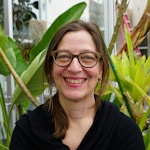Growing Myceliated Facades
Manufacturing and exposing experimental panels in a facade setting
Presented on August 12, 2020 at Facade Tectonics 2024 World Congress
Sign in and Register
Create an Account
Overview
Abstract
Today's sustainability in architecture takes into consideration the complete life cycle of buildings and their components, from resource harvesting and material production to recycling. In recent years, the concept of living architecture has emerged and seeks to integrate principles of life to architecture to reduce resource consumption. The principle of biological growth has architectural potential such as: adaptation, resilience, dynamics, differentiation and continuous functionality. In order to optimize the building process, the principle of growth can be applied to different building stages, from material production and building construction to operation and maintenance. In this regard, biomimetics and biotechnology serve as methods of transferring biology to architecture by abstracting and using principles in artificial systems, and by integrating living organisms into the design and production process. This paper presents existing projects that use biological organisms in various stages of material production, building construction, operation and maintenance. A case study on myceliated material, where fungal mycelium is grown on agricultural waste, was carried out and provides an explanation of this process and its potential. Mycelium functions as a connecting network, solidifying otherwise amorphous substrate. Panels targeting diverse architectural functions can be made from myceliated panels by changing growth conditions and post-growth treatments. This case study focused on scaling the mycelium growth process up from laboratory scale to large panels that were implemented in an outdoor environment as a prototypical facade. In conclusion, despite the lack of actual growth in today's buildings, growth using biological organisms is well-discussed and an expanding field. The case study showcases the potential of implementing biological organisms in facade prototypes to serve in material production and building operation stages. These research projects bring the integration of biological systems in architecture one step closer to changing current practices in the building industry.
Authors

Thibaut Houette, M. Arch.
Integrated Bioscience PhD student
University of Akron
th153@zips.uakron.edu

Brian Foresi
Biomedical Sciences (BS/MD) student
University of Akron
bf39@zips.uakron.edu

Christopher Maurer, AIA, NCARB
Founder and Principal Architect
Redhouse Studio
chris@redhousestudio.net

Dr. Petra Gruber
Assoc. Prof.
University of Akron
pgruber@uakron.edu
Keywords
Introduction
Numerous architects and research groups discuss the concept of living architecture and seek to integrate principles of life to architecture in order to reduce resource consumption (Beesley, Hastings, and Bonnemaison
Access Restricted
Materials and Methods
Manufacturing the myceliated panels
The major parameters about manufacturing studied in this research were the substrate on which the mycelium was grown, the sterilization method and the growth environment. All batches
Access Restricted
Results
Results of the manufacturing process
The resulting growth of the myceliated panels was assessed at specific points in time to compare the efficiency of the manufacturing methods. The amount of elm
Access Restricted
Discussion
Discussion on manufacturing the myceliated panels
Many variables were applied to this manufacturing process in order to identify promising pathways for follow-up projects. As the overview scheme in Figure 6 describes
Access Restricted
Conclusion and Future Work
For the myceliated panels production, the optimal combination was made of red oak saw dust with soy hull and gypsum, which was pasteurized and grown in tents allowing air exchange
Access Restricted
Acknowledgements
This study was part of the Living Wall System project supported by The University of Akron, with a Faculty Research Grant 2018. The LIWAS team was composed of Petra Gruber, Thibaut Houette, Ariana Rupp and Brian Foresi. The manufacturing process was carried out in collaboration with and using facilities of redhouse studio, with principal architect Christopher Maurer. The authors would like to thank Jeff Spencer, Lara Roketenetz and Claudia Naményi for the installation of the prototype at The University of Akron's field station at the Bath Nature Preserve. All images are copyright of the authors, unless stated otherwise.
Rights and Permissions
Appels, Freek V.W., Serena Camere, Maurizio Montalti, Elvin Karana, Kaspar M.B. Jansen, Jan Dijksterhuis, Pauline Krijgsheld, and Han A.B. Wösten. 2019. “Fabrication Factors Influencing Mechanical, Moisture- and Water-Related Properties of Mycelium-Based Composites.” Materials & Design 161 (January): 64–71. https://doi.org/10.1016/J.MATDES.2018.11.027.
Archdaily. 2014. “Hy-Fi, The Organic Mushroom-Brick Tower Opens At MoMA’s PS1 Courtyard.” 2014. https://www.archdaily.com/521266/hy-fi-the-organic-mushroom-brick-tower-opens-at-moma-s-ps1-courtyard.
Archdaily. 2015. “Vincent Callebaut’s 2050 Vision of Paris as a ‘Smart City.’” 2015. https://www.archdaily.com/585254/vincent-callebaut-s-2050-parisian-vision-of-a-smart-city.
Archdaily. 2017. “This Pavillion Lives and Dies Through Its Sustainable Agenda.” 2017. https://www.archdaily.com/878519/this-pavillion-lives-and-dies-through-its-sustainable-agenda.
Armstrong, Rachel, and Neil Spiller. 2010. “Synthetic Biology: Living Quarters.” Nature 467 (October): 916–18. https://doi.org/10.1038/467916a.
Bader, Christoph, William G Patrick, Dominik Kolb, Stephanie G Hays, Steven Keating, Sunanda Sharma, Daniel Dikovsky, et al. 2016. “Grown, Printed, and Biologically Augmented: An Additively Manufactured Microfluidic Wearable, Functionally Templated for Synthetic Microbes.” 3D Printing and Additive Manufacturing 3 (2): 79–89. https://doi.org/10.1089/3dp.2016.0027.
Batakliev, Todor, Vladimir Georgiev, Metody Anachkov, Slavcho Rakovsky, and Gennadi E Zaikov. 2014. “Ozone Decomposition.” Interdisciplinary Toxicology 7 (2): 47–59. https://doi.org/10.2478/intox-2014-0008.
Beesley, Philip, Sascha Hastings, and Sarah Bonnemaison. 2019. Living Architecture Systems Group White Papers 2019. Edited by Philip Beesley, Sascha Hastings, and Sarah Bonnemaison. Kitchener, Ontario: Riverside Architectural Press. www.riversidearchitecturalpress.ca.
Benyus, Janine M. 1997. Biomimicry: Innovation Inspired by Nature. Harper Perennial.
Briggs, Winslow R. 2016. “How Do Sunflowers Follow the Sun—and to What End?” Science 353 (6299): 541–42. https://doi.org/10.1126/science.aah4439.
D’Amours, Sophie, Mikael Rönnqvist, and Andres Weintraub. 2008. “Using Operational Research for Supply Chain Planning in the Forest Products Industry.” INFOR: Information Systems and Operational Research46 (4): 265–81. https://doi.org/10.3138/infor.46.4.265.
Dade-Robertson, Martyn, Javier Rodriguez Corral, Helen Mitrani, Meng Zhang, Anil Wipat, Carolina Ramirez-Figueroa, and Luis Hernan. 2016. “Thinking Soils: A Synthetic Biology Approach to Material-Based Design Computation,” October. http://nrl.northumbria.ac.uk/28180/.
Dade-Robertson, Martyn, Helen Mitrani, Javier Rodriguez Corral, Meng Zhang, Luis Hernan, Aurelie Guyet, and Anil Wipat. 2018. “Design and Modelling of an Engineered Bacteria-Based, Pressure-Sensitive Soil.” Bioinspiration & Biomimetics 13 (4): 046004. https://doi.org/10.1088/1748-3190/aabe15.
Dosier, Ginger, Krieg. 2016. Production of masonry with bacteria, issued August 26, 2016. https://patents.google.com/patent/US9796626B2/en.
Drack, Manfred, Mirco Limpinsel, Gerd de Bruyn, James H. Nebelsick, and Olivier Betz. 2017. “Towards a Theoretical Clarification of Biomimetics Using Conceptual Tools from Engineering Design.” Bioinspiration & Biomimetics 13 (1). https://doi.org/10.1088/1748-3... Design. 2018. “MycoComposite 029 - Hemp Mycelium Panel.” Green Island. https://s3-us-west-2.amazonaws... Design. 2019. “Ecovative Design.” 2019. https://ecovativedesign.com/.
Elsacker, Elise, Simon Vandelook, Joost Brancart, Eveline Peeters, and Lars De Laet. 2019. “Mechanical, Physical and Chemical Characterisation of Mycelium-Based Composites with Different Types of Lignocellulosic Substrates.” BioRxiv, March, 569749. https://doi.org/10.1101/569749.
Fayemi, Pierre-Emmanuel, Kristina Wanieck, Cordt Zollfrank, Nicolas Maranzana, and Améziane Aoussat. 2017. “Biomimetics: Process, Tools and Practice.” Bioinspiration and Biomimetics 12 (1). https://doi.org/10.1088/1748-3190/12/1/011002.
Gruber, Petra. 2008. “The Signs of Life in Architecture.” Bioinspiration & Biomimetics 3 (2): 023001. https://doi.org/10.1088/1748-3182/3/2/023001.
Gruber, Petra. 2011. Biomimetics in Architecture - Architecture of Life and Buildings. Vienna: Springer. https://doi.org/10.1007/978-3-7091-0332-6.
Haneef, Muhammad, Luca Ceseracciu, Claudio Canale, Ilker S. Bayer, José A. Heredia-Guerrero, and Athanassia Athanassiou. 2017. “Advanced Materials From Fungal Mycelium: Fabrication and Tuning of Physical Properties.” Scientific Reports 7 (1): 41292. https://doi.org/10.1038/srep41292.
Hawkes, Elliot W., Laura H. Blumenschein, Joseph D. Greer, and Allison M. Okamura. 2017. “A Soft Robot That Navigates Its Environment through Growth.” Science Robotics 2 (8): eaan3028. https://doi.org/10.1126/scirobotics.aan3028.
Hays, Stephanie G, William G Patrick, Marika Ziesack, Neri Oxman, and Pamela A Silver. 2015. “Better Together: Engineering and Application of Microbial Symbioses.” Current Opinion in Biotechnology 36 (December): 40–49. https://doi.org/10.1016/J.COPBIO.2015.08.008.
Heisel, Felix, Karsten Schlesier, Juney Lee, Matthias Rippmann, Nazanin Saeidi, Alireza Javadian, Reza Nugroho, Adi, Dirk Hebel, and Philippe Block. 2017. “Design of a Load-Bearing Mycelium Structure through Informed Structural Engineering.” In Proceeding of the World Congress on Sustainable Technologies (WCST), 1–5. http://www.block.arch.ethz.ch/brg/publications/781.
Hwang, Nathaniel S, Shyni Varghese, and Jennifer Elisseeff. 2008. “Controlled Differentiation of Stem Cells.” Advanced Drug Delivery Reviews 60 (2): 199–214. https://doi.org/10.1016/j.addr.2007.08.036.
Imhof, Barbara, and Petra Gruber. 2015. Built to Grow : Blending Architecture and Biology. Birkhäuser.
Imhof, Barbara, Molly Hogle, Waltraut Hoheneder, Rachel Armstrong, Simone Ferracina, Loannis Leropoulos, Jiseon You, et al. 2018. “Living Architecture: Metabolic Programmable Apps as Part of Life Support Systems.” Rome. https://livingarchitecture-h2020.eu/2018/05/21/metabolic-programmable-apps-as-part-of-life-support-systems/.
Inhabitat. 2014. “Phillip Ross Molds Fast-Growing Fungi Into Mushroom Building Bricks That Are Stronger than Concrete.” 2014. https://inhabitat.com/phillip-ross-molds-fast-growing-fungi-into-mushroom-building-bricks-that-are-stronger-than-concrete/.
Inhabitat. 2016. “Trio of Living Green Buildings Reinvent Paris as a Thriving Sustainable Ecosystem.” 2016. https://inhabitat.com/trio-of-... Organization for Standardization. 2015. “ISO 18458:2015 Biomimetics -- Terminology, Concepts and Methodology,” 1–6. https://www.iso.org/standard/62500.html.
Islam, Mohammad Retaful, Gregory Tudryn, Ronald B. Bucinell, Linda S. Schadler, and R. C. Picu. 2017. “Morphology and Mechanics of Fungal Mycelium.” Scientific Reports 7 (1): 1–12. https://doi.org/10.1038/s41598-017-13295-2.
Islam, Mohammad Retaful, Gregory Tudryn, Ronald B. Bucinell, Linda S. Schadler, and R. C. Picu. 2018. “Mechanical Behavior of Mycelium-Based Particulate Composites.” Journal of Materials Science 53 (24): 16371–82. https://doi.org/10.1007/s10853-018-2797-z.
Jiang, Lai, Daniel Walczyk, Gavin McIntyre, and Ronald B. Bucinell. 2016. “A New Approach to Manufacturing Biocomposite Sandwich Structures: Mycelium-Based Cores.” In Volume 1: Processing, V001T02A025. ASME. https://doi.org/10.1115/MSEC2016-8864.
Jones, Mitchell, Tanmay Bhat, Everson Kandare, Ananya Thomas, Paul Joseph, Chaitali Dekiwadia, Richard Yuen, Sabu John, Jun Ma, and Chun-Hui Wang. 2018. “Thermal Degradation and Fire Properties of Fungal Mycelium and Mycelium - Biomass Composite Materials.” Scientific Reports 8 (1): 17583. https://doi.org/10.1038/s41598-018-36032-9.
Jones, Mitchell, Tien Huynh, Chaitali Dekiwadia, Fugen Daver, and Sabu John. 2017. “Mycelium Composites: A Review of Engineering Characteristics and Growth Kinetics.” Journal of Bionanoscience 11 (4): 241–57. https://doi.org/10.1166/jbns.2017.1440.
Kennedy, Brook S., Christopher Maurer, and William Sullivan. 2018. “Bio-Fabrication and Bio-Inspired Manufacturing Techniques for the Built Environment.” In Advances in Manufacturing and Processing of Materials and Structures, 95–122. Boca Raton: CRC Press. https://doi.org/10.1201/b22020-5.
Kurtzman, Ralph H. 2010. “Pasteurization of Mushroom Substrate and Other Solids.” African Journal of Environmental Science and Technology 4 (13): 936–41. http://www.academicjournals.org/AJEST.
Kutschera, Ulrich, and Winslow R. Briggs. 2016. “Phototropic Solar Tracking in Sunflower Plants: An Integrative Perspective.” Annals of Botany 117 (1): 1–8. https://doi.org/10.1093/aob/mcv141.
Lambers, Hans, F. Stuart Chapin, and Thijs L. Pons. 2008. “Life Cycles: Environmental Influences and Adaptations.” In Plant Physiological Ecology, 375–402. New York, NY: Springer New York. https://doi.org/10.1007/978-0-387-78341-3_11.
Lenau, Torben A., Anna-Luise Metze, and Thomas Hesselberg. 2018. “Paradigms for Biologically Inspired Design.” In Bioinspiration, Biomimetics, and Bioreplication VIII, edited by Akhlesh Lakhtakia, 10593:1. SPIE. https://doi.org/10.1117/12.2296560.
Longaker, Michael T., David J. Whitby, Mark Ferguson, H. Peter Lorenz, Michael Harrison, and N. Scott Adzick. 1994. “Adult Skin Wounds in the Fetal Environment Heal with Scar Formation.” Annals of Surgery219 (1): 65–72. https://doi.org/10.1097/00000658-199401000-00011.
Luo, Jing, Xiaobo Chen, Jada Crump, Hui Zhou, David G. Davies, Guangwen Zhou, Ning Zhang, and Congrui Jin. 2018. “Interactions of Fungi with Concrete: Significant Importance for Bio-Based Self-Healing Concrete.” Construction and Building Materials 164 (March): 275–85. https://doi.org/10.1016/J.CONBUILDMAT.2017.12.233.
Mazzoleni, Ilaria, and Shauna Price. 2013. Architecture Follows Nature- Biomimetic Principles for Innovative Design.
Mellon, Stephen J., and K E Tanner. 2012. “Bone and Its Adaptation to Mechanical Loading: A Review.” International Materials Reviews57 (5): 235–55. https://doi.org/10.1179/1743280412Y.0000000008.
Metcalfe, Daniel B., Patrick Meir, Luiz Eduardo O. C. Aragão, Antonio C. L. da Costa, Alan P. Braga, Paulo H. L. Gonçalves, Joao de Athaydes Silva Junior, et al. 2008. “The Effects of Water Availability on Root Growth and Morphology in an Amazon Rainforest.” Plant and Soil 311 (1–2): 189–99. https://doi.org/10.1007/s11104... Hoyos, Carlos, and Carlos Fiorentino. 2016. “Bio-Utilization, Bio-Inspiration, and Bio-Affiliation in Design for Sustainability : Biotechnology, Biomimicry, and Biophilic Design.” The International Journal of Designed Objects 10 (3): 1–18. https://doi.org/DOI: 10.18848/2325-1379/CGPV10I03.
Morita, Miyo Terao. 2010. “Directional Gravity Sensing in Gravitropism.” Annual Review of Plant Biology 61 (1): 705–20. https://doi.org/10.1146/annurev.arplant.043008.092042.
Morrison, Sean J., Nirao M. Shah, and David J. Anderson. 1997. “Regulatory Mechanisms in Stem Cell Biology.” Cell 88 (3): 287–98. https://doi.org/10.1016/S0092-8674(00)81867-X.
Otto, Frei, Rainer Barthel, Berthold Burkhardt, Heide Drüsedau, Rainer Graefe, Jürgen Hennicke, Georgina Krause-Valdovinos, Eda Schaur, Ilse Schmall, and Cornelius Thywissen. 1985. Natürliche Konstruktionen, Formen Und Strukturen in Natur Und Technik Und Prozesse Ihrer Entstehunng. 2nd ed. Stuttgart: Deutsche Verlags-Anstalt.
Oxman, Neri, Jared Laucks, Markus Kayser, Jorge Duro-Royo, and David Gonzalez Uribe, Carlos. 2014. “Silk Pavilion: A Case Study in Fiber-Based Digital Fabrication — MIT Media Lab.” 2014. https://www.media.mit.edu/publications/silk-pavilion-a-case-study-in-fiber-based-digital-fabrication/.
Pawlyn, Michael. 2016. Biomimicry in Architecture. 2nd ed. RIBA Publishing.
Pelletier, M.G., G.A. Holt, J.D. Wanjura, E. Bayer, and G. McIntyre. 2013. “An Evaluation Study of Mycelium Based Acoustic Absorbers Grown on Agricultural By-Product Substrates.” Industrial Crops and Products 51 (November): 480–85. https://doi.org/10.1016/J.INDC... studio. 2019. “Bioterials.” 2019. http://www.redhousearchitecture.org/mycoterials.
Sadeghi, Ali, Alessio Mondini, and Barbara Mazzolai. 2017. “Toward Self-Growing Soft Robots Inspired by Plant Roots and Based on Additive Manufacturing Technologies.” Soft Robotics 4 (3): 211–23. https://doi.org/10.1089/soro.2016.0080.
Schmier, Stefanie, Sandra Eckert, Viktor Gudenus, Marco Caliaro, Georg Bauer, and Thomas Speck. 2016. “Mechanical Tests with Mycelium Stabilized Paper-Straw-Grain-Samples.” In Built to Grow - Blending Architecture and Biology, 99–103. Berlin, Boston: De Gruyter. https://doi.org/10.1515/9783035607475-010.
Sinnott, Edmund W. 1952. “Reaction Wood and the Regulation of Tree Form.” American Journal of Botany 39 (1): 69–78. https://doi.org/10.2307/2438096.
Teitelbaum, Steven L. 2007. “Osteoclasts: What Do They Do and How Do They Do It?” The American Journal of Pathology 170 (2): 427–35. https://doi.org/10.2353/ajpath.2007.060834.
Tokuç, Ayça, Fatma Feyzal Özkaban, and Özge Andiç Çakır. 2018. “Biomimetic Facade Applications for a More Sustainable Future.” In Interdisciplinary Expansions in Engineering and Design With the Power of Biomimicry. InTech. https://doi.org/10.5772/intechopen.73021.
Trask, Richard S., and Ian Paul Bond. 2009. “Biomimicry of Plantae Vascules in the Development of Self-Healing Composite Structures.” https://researchportal.bath.ac.uk/en/publications/biomimicry-of-plantae-vascules-in-the-development-of-self-healing.
Travaglini, S., J. Noble, P.G. Ross, and C.K.H. Dharan. 2013. “Mycology Matrix Composites.” In 28th Annual Technical Conference of the American Society for Composites 2013 : State College, Pennsylvania, USA, 9-11 September 2013, 517–35. PROCEEDINGS- AMERICAN SOCIETY FOR COMPOSITES. Red Hook, NY: Curran Associates, Inc. https://www.tib.eu/en/search/i... Deutscher Ingenieure. 2012a. “VDI 6220 Blatt 1: Biomimetics Conception and Strategy - Differences between Biomimetic and Conventional Methods/Products,” no. December: 1–36.
Verein Deutscher Ingenieure. 2012b. “VDI 6224 Blatt 1: Biomimetic Optimization: Application of Evolutionary Algorithms,” no. June: 1–39.
Vincent, Julian Francis Vincent. 2009. “Biomimetics — a Review.” In Proceedings of the Institution of Mechanical Engineers, Part H: Journal of Engineering in Medicine, 223:919–39. SAGE PublicationsSage UK: London, England. https://doi.org/10.1243/09544119JEIM561.
Whippo, Craig W., and Roger P. Hangarter. 2006. “Phototropism: Bending towards Enlightenment.” The Plant Cell 18 (5): 1110. https://doi.org/10.1105/TPC.105.039669.
Winiski, Jacob, Sue Van Hook, Matthew Lucht, and Gavin McIntyre. 2016. Process for Solid-state Cultivation of Mycelium on a Lignocellulose Substrate. US20160264926A1, issued March 9, 2016. http://appft.uspto.gov/netacgi/nph-Parser?Sect1=PTO1&Sect2=HITOFF&p=1&u=/netahtml/PTO/srchnum.html&r=1&f=G&l=50&d=PG01&s1=20160264926.PGNR.
Yang, Zhaohui (Joey), Feng Zhang, Benjamin Still, Maria White, and Philippe Amstislavski. 2017. “Physical and Mechanical Properties of Fungal Mycelium-Based Biofoam.” Journal of Materials in Civil Engineering29 (7): 04017030. https://doi.org/10.1061/(ASCE)MT.1943-5533.0001866.
Ziegler, Alexander R, Sreekala G Bajwa, Greg A Holt, Gavin McIntyre, and Dilpreet S Bajwa. 2016. “Evaluation of Physico-Mechanical Properties of Mycelium Reinforced Green Biocomposites Made from Cellulosic Fibers.” Applied Engineering in Agriculture 32 (6): 931–38. https://doi.org/10.13031/aea.32.11830.
Author Comments
Thibaut Houette1 *, Brian Foresi1, Christopher Maurer2, Petra Gruber3
1 Department of Biology, The University of Akron, 235 Carroll Street, Akron, OH 44325, USA
2 redhouse studio, 1455 West 29th Street, Cleveland, OH 44113, USA
3 Biomimicry Research and Innovation Center, Myers School of Art and Department of Biology, The University of Akron, 150 East Exchange Street, Akron, OH 44325, USA